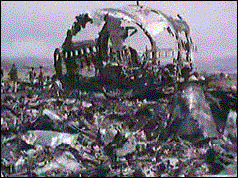
Airplane crashes with ties to language
NOTE: Italics indicate those aspects of English oral communication explained directly or indirectly within my thesis/ book.
1960, New York. 134 deaths. No actual 'hand-off' from one control facility to the other.
1966, French Alps. 117 deaths. A controller's collision warning was misunderstood as an acknowledgement of a previous transmission.
1967, France. 88 deaths. Misunderstandings between the crew and the controller, attributed to language difficulties and, in particular, the lack of standard phraseology used.
1967, England. 72 deaths. An advisory accepted as an instruction and referential problems in an ensuing message.
1969, Vietnam. 75 deaths. Pilot misconstrued or, on account of overlapping communications, did not completely hear instructions.
1970, Canada. 109 deaths. Instruction manuals provided by the manufacturer contained information that was misleading.
1970, USA. 75 deaths. Copilot did not make required callouts and captain missed actual MDA.
1971, Alaska. 111 deaths. Misleading navigational information.
1972, Florida. 100 deaths. The ATC made a non-standard query. (cf. 2:38 to 2:55 in movie)
1973, France. 68 deaths. Controller used phrase 'stand by' wrongly.
1974, Virginia / USA . 92 deaths. Different understanding of what an approach clearance actually includes.
1976, Zagreb. 176 deaths. Yugoslav pilot and controller conversed in Serbo-Croat which prevented the British pilots from being aware of the danger.
1977, Tenerife. 583 deaths. Dutch pilot used English words with Dutch meaning.
1978, Rochester / USA . No deaths. Aircraft severely damaged/ destroyed. Reason: copilot did ask his captain to make a go-around too hesitatingly.
1978, Portland / USA. Copilot failed to convey lack of fuel to the captain with resolution.
1979, Mexico. 72 deaths. Required callouts were not made during descent.
1980, Tenerife. 146 deaths. Confusion between turns left and turn left .
1981, California. 34 injuries. Confusion over the meaning of the term hold .
1981, Corsica. 180 deaths. Ambiguous language. Hit high ground.
1983, Madrid. 181 deaths. Wrong communication procedure.
1985, Japan. 520 deaths. Sticking to culturally induced register impaired information flow from copilot to captain.
1986, East Berlin. 72 deaths. Confusion between right and left runway.
1989, Azores. 144 deaths. Communication error with tower. No use of standard phraseology, informal cockpit conversations.
1989, Surinam. 176 deaths. Pilot ignored GPWS instructions, possibly because of language mismatch.
1990, New York. 73 deaths. Failure of the crew to communicate the shortage of fuel to ATC (copilot did not use the word “emergency”). Lack of resolution.
1992, Nepal. 113 deaths. Non-standard phraseology. Not proficient enough in English.
1993, China. 16 deaths. Pilot did not understand English warning of ground proximity.
1994, Japan. 264 deaths. Chinese pilot ; autopilot with English instructions.
1995, Colombia. 159 deaths. Confusion between charts and flight management system, similarity of beacon names Roso and Romeo; controller's inability to speak conversational English.
1996, USA. 2 deaths. Failure of the pilots to effectively monitor the common traffic advisory radio frequency. Contributing to the cause of the accident was interrupted radio transmission , which led to pilots' misunderstanding of the transmission.
1996, India. 349 deaths. Midair collision. Three native languages involved: Hindi, Arabic, Kazakh. Important factor: Lack of English language proficiency.
1997, Seattle. No deaths. Russian pilot could not talk to the controller in English, began to land on a city street. (a similar event also occurred in 1999 in Israel)
1997, Indonesia. 234 deaths. Confusion about whether being instructed to turn right or left.
1998, Taiwan. 196 deaths. Blame placed on communication, coordination, cooperation.
1999, Chicago. No deaths. Chinese Boeing 747 misunderstood taxi directions, got in front of another 747 taking off. The latter alertly lifted his wing and averted a collision.
1999, Shanghai. 8 deaths. Korean pilot, Chinese controller.
1999, New York. No deaths. Near collision. Three languages: Icelandic, French, English.
1999, England. No deaths. Near collision, Korean and British 747's.
1999, Kosovo. 24 deaths. Italian pilot of this UN flight told controller he could not understand computer-generated English, presumably a ground proximity alarm.
2000, Paris. 1 death. Collision on the ground. One plane was controlled in English, one in French.
2000, Taiwan. 83 deaths. Singapore Airlines 747 misunderstood, used runway 6Right instead of 6 Left, and collided with construction site.
2001, Japan. No deaths. Two Japan Airliners at 36,000 feet missed each other by only 33 feet, due to a confusing exchange of instructions from controllers . 700 might have died.
2001, Peru. 2 deaths. Missionary plane shot down in Spanish-English confusion.
2001, Milan. 118 deaths. German pilot, Italian controller. Took wrong runway into path of an SAS plane taking off.
2001, Seattle. No deaths. A TWA MD-80 flew over an American Airlines MD-80, missing it by an estimated 60 feet. The tower local controller had cleared TWA for takeoff from runway 16L and instructed American Airlines to hold short of the runway. However, the flight crew misunderstood the controller and crossed 16L.
2002, Alaska. No deaths. China Air took off from taxiway instead of runway, in downwind direction. Barely cleared airfield. The pilot could not have understood the clearance instructions.
2002, Korea. 118 deaths. Chinese pilot, Korean ATC .
2005, Greece. 121 deaths. German captain and Cypriot copilot were unable to talk adequately about technical problems concerning a pressure relief valve in English language.
2006, Poland. No deaths. Seemingly because of a poor command of English a Turkish charter plane landed at a Polish airbase instead of a civilian airport. (cf. article)
2007, New York. No deaths. Chinese pilots were not able to understand taxi instructions given by the ground controller. (cf. movie)
2008, London. No deaths. Polish pilots were not able to understand instructions given by the controller.
2010, St. Petersburg. No deaths. Russian controller encountered communicative problems while dealing with an emergency traffic affected by a "bird strike". (cf. everything in the movie)